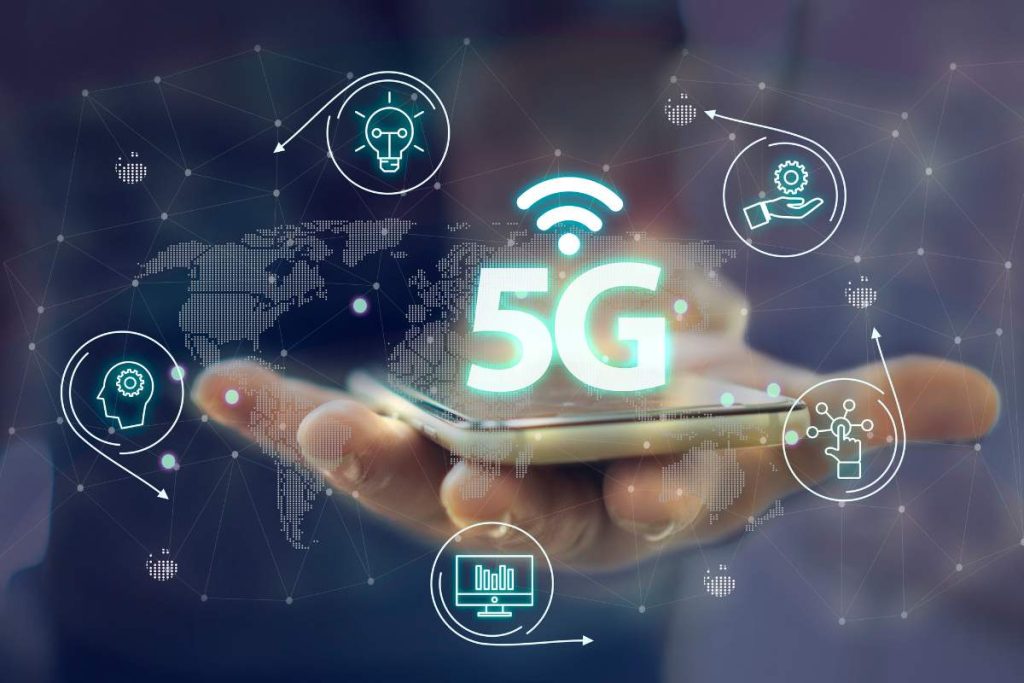The 5G Revolution: Transforming Connectivity and Communication

The advent of the 5G network marks a significant milestone in the evolution of wireless communication technology. With promises of unprecedented speed, low latency, and enhanced connectivity, 5G is set to revolutionize various aspects of our digital lives. This next-generation network is not just an upgrade from 4G LTE but a complete overhaul that brings a new era of possibilities for mobile internet, home internet, and the broader internet of things (IoT). As we stand on the brink of this technological leap, it is essential to understand what 5G entails, how it differs from previous generations, and its potential impact on our daily lives and industries.
Understanding 5G Technology
Fifth-generation wireless (5G) technology will be more than 100 times faster than 4G LTE And 5G is far more advanced than 4G LTE or previous wireless technologies. It was created to address increasing demand for data and connectivity as digital interaction becomes more ubiquitous. The spectrum used by 5G contains higher frequency bands in the ‘millimetre wave’ (mmWave) spectrum, which enable lightening-fast data transfer rates and ultra-low latency. 5G can deliver speeds that are up to 100 times faster than 4G LTE, providing them on demand. Its higher spectrum also allows for the use of new features such as massive MIMO (multiple input, multiple output) and beamforming, which increase both signal intensity and coverage. This equates to better-behaved signals that service more users in a wide area, including dense urban environments.
Along with speed, the addition of ultra-reliable low latency communication (URLLC) would help make 5G technology suitable for applications requiring instantaneous responsiveness, one of the significant changes introduced by the new version. 5G applications relevant to emerging technologies such as autonomous vehicles, robot-assisted surgery and industrial automation would especially benefit from this development. As its title suggests, low latency means that the shorter the gap between passing information or data and receiving a response from the receiver, the more efficient the transmission is for applications in which even a millisecond delay could be detrimental. 5G networks are also expected to become more energy-efficient, potentially contributing to setting more realistic battery targets for fully connected devices across various applications.
The Impact of 5G on Mobile Devices
With 5G phones finally hitting the market, consumers of mobile-internet-related devices, such as smartphones, will now be able to reap the benefits of mobile internet connectivity, with far better results than before. A user watching prioritised high-definition (HD) video content will be able to enjoy a much smoother experience using a 5G phone; downloading a 5GB HD movie file will take a fraction of the time it used to. When it comes to playing Fortnite and other online multiplayer games with friends, users of 5G phones will experience more responsive and precise play. There are even advantages for mobile payment options such as Apple Pay and Samsung Pay by using 5G to complete the transactions faster. When these phones are used outside, in 5G coverage areas (which, because of the technology’s shorter range, can get quite crowded in stadiums and urban centres), connectivity will be much more reliable compared to the already-bottlenecked 4G networks of today.
More than mere phone phones, 5G will unlock new applications that were beyond the reach of 4G LTE. With higher data transfer rates and ultra-low latencies, 5G will finally enable the ‘immersive and responsive experience’ of augmented reality (AR) and virtual reality (VR). Beyond making phones ever camera-like and then image-editing-liker and then magically mirroring devices, 5G will also kick-start more sophisticated applications, since the phones will spawn the technology of mobile edge computing, in which data processing takes place near to the user, rather than remotely on massive servers. Naturally, this will edge online gaming or other time-sensitive applications that demand low latency. But the technology will also open avenues for new services and apps, such as automatic real-time language translation (businesses will love it, obviously), or super-powerful mobile games and online content that adapts to fit whatever device you have to hand.
5G Home Internet and WiFi
5G won’t just be for mobile phones – it’s also coming to home internet. 5G home internet can provide high-speed internet connections without wires via the same wireless 5G antenna towers that provide mobile 5G phone services. It will likely offer faster speeds and lower latency compared with most existing wired broadband, making it an attractive option for homes and businesses. For those who want to stream 4K and 8K videos, download large files quickly or seamlessly game online without cables all over the place, 5G home internet is the way to go.
Along with 5G home internet, 5G WiFi will supercharge the home and the office by promising to simultaneously connect more devices, with reduced latency and a tenfold increase in bandwidth compared with 4G. In a smart home, with dozens of IoT devices – from smart thermostats, security cameras, to voice assistants – it’s essential that they reliably operate at outstanding performance and with integrity. 5G WiFi will ensure that the internet connections allow devices in your smart home to give you the best possible user experience.
5G vs. LTE: Key Differences
Even though 4G LTE has served us well the past decade by providing faster networking and modest savings on your phone bill, 5G is different. 5G is faster. A lot faster. Where LTE might deliver peak speeds of about a 1 Gbps, 5G theoretically reaches upgrade to 10 Gbps. Suddenly, you can download your movies in seconds, instantly stream all those HD videos and TV series shows without buffering, and experience online gaming with quicker responses. As well, 5G has lower latency of around 1 millisecond vs LTE’s 30-50 milliseconds, crucial to applications for real-time interaction, such as an autonomous vehicle or even remote medical procedures.
One other factor that distinguishes 5G from LTE is the number of connected devices that it can support. 5G networks are designed to provide many more devices per square kilometre than current LTE networks, which makes it a good fit for densely populated urban areas and large events that require a lot of people to get online in a given space. This characteristic can also greatly aid development of IoT: as more and more devices can benefit from being connected to the internet, 5G will be able to support this demand from a spectrum efficiency perspective. Considering that demand for wireless data is forecast to increase by a factor of 10 between ten years ago and the next decade, this fit will be quite important as well.
The Role of 5G Towers in Network Deployment
5G towers are the enablers of 5G. These are the ‘base stations’ that support the entire network, and it is in the 5G towers that the radio part of the network is implemented. These towers are very much a hybrid of the complex technologies needed to support the next generation of 5G networks. Designers know that the higher capacity of 5G requires the use of massive MIMO and beamforming antenna designs, on towers that have to operate in higher frequency bands and that need to be in a much denser configuration of tiny cells in order to provide blanket coverage where users expect the enhanced speeds and low latency of 5G to be delivered, even in spots with thousands of users all consuming ever more data.
There are also challenges in deploying 5G towers such as obtaining regulatory permissions, site availability and response to public concern over health and environmental issues. Despite these challenges, the deployment of 5G towers continues at a rapid pace as telecom players expand their 5G network infrastructure deployments. We will continue to see an increase in the numbers of 5G towers installed and the service footprint rapidly expanding across urban and rural areas. As more 5G towers become available, the coverage and quality of the 5G services can only improve to provide faster, more stable internet connections to users around the world. This expansion and availability of 5G is essential for 5G to fulfil its promise so that new applications and services can be created and delivered as part of a better internet revolution to enhance our social and economic prosperity.
The Future of 5G and Its Broader Implications
Visionaries and cynics alike can all point to a lot of exciting possibilities for 5G, with smart cities and smart factories being hailed as two of the most likely areas to transform and see widespread adoption. The 5G use cases will be as far-reaching as 4G, particularly in the deployment of smart cities, where actionable data from nearly every vertical will be harnessed to create efficiencies in urban systems – from traffic management and public safety to environmental monitoring and much more. Mayors globally will be able to leverage high-performing machine-to-machine communications to optimise various city infrastructure components, such as building management, waste management and recycling efforts. The high-frequency connections will be a boon in reducing congestion and making urban travel more enjoyable. In general, the environment will be more pleasing to live and work in. Likewise, the Internet of Things (IoT) applications in industry will greatly stand to benefit from intelligent factories 5G. A recently conducted survey put forth by the nonprofit IoT M2M Council and the management consulting firm Frost & Sullivan in September 2020 indicates that 97 per cent of the survey respondents plan to have at least a portion of their manufacturing processes integrated in highly automated smart factories within five years. According to Tom Kane, executive director of the IoT M2M Council, a smart factory, or ‘Industrial Internet of Things’, encompasses supply chain, manufacturing, assets, logistics and service operations optimisation.
Other than from smart cities or industries, 5G will bring innovation to other two segments including health care, education and entertainment. From health care, 5G will assure low latency and high reliability for telemedicine and remote surgery, furthermore, 5G can allow the connectivity for advanced medical devices, such as two-way data uploading and down line during online treatment. From education, 5G provides the transparent and high quality experience to teaching and learning in remote areas, virtual classrooms, interactive learning content, and finally, the learning outcome can also be measured using big data analytics. From the entertainment sector, 5G can bring users futuristic immersive media environment like the introduction of AR and VR experience. 5G has the potential to accelerate digital growth and innovation in all sectors in future.
Conclusion
The advent of 5G technology represents a revolution in wireless communication, offering unprecedented speed, low latency, and enhanced connectivity. From transforming mobile devices and home internet to enabling the development of smart cities and advanced industrial applications, the impact of 5G is far-reaching and profound. As we embrace this new era of connectivity, it is essential to understand the key differences between 5G and previous generations, the role of 5G towers in network deployment, and the broader implications for various industries. With continued investment and innovation, 5G has the potential to reshape our digital landscape and unlock new possibilities for growth and development in the years to come.







